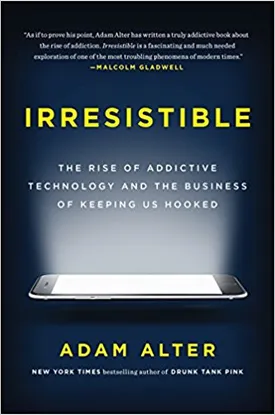Irresistible: The Rise of Addictive Technology and the Business of Keeping Us Hooked by Adam Alter
The world around us is becoming increasingly “irresistible.” We are constantly bombarded with new technologies and gadgets, many of which draw us in and keep us hooked for hours - if not days - at a time. But what social, psychological, and economic forces are behind this irresistible technology? In his book “Irresistible: The Rise of Addictive Technology and the Business of Keeping Us Hooked”, Adam Alter examines the relationship between society, technology, and addiction. Through an in-depth analysis of the business and psychological landscapes which gave rise to the irresistible technology, Alter sheds light on the motivations which drive us to use these technologies and the effects it is having on our lives.
At the heart of Alter’s argument is the idea that resistible technologies have been replaced by irresistible ones, which are specifically designed to engage, or “captivate” users. These technologies often employ “variable reinforcement schedules” which act as rewards and punishments that keep users coming back for more. As they become more aware of how these technologies manipulate them, users are increasingly choosing to indulge in them over other activities like sports or reading.
Alter also investigates how technology addiction is created, explaining how features such as “achievement loops” and “autoplay” create compulsive engagement and how the seemingly innocuous design of individual apps and websites can be just as addictive as drugs or alcohol. He examines how these technologies have come to define our lives, leading to an increase in depression, anxiety, and loneliness. He reveals the depth of the problem, quoting the World Health Organization (WHO) which has classified “gaming disorder” as a mental health condition.
The book then addresses the social and economic aspects of addiction, pointing out the issue of “platform capitalism” which has powered the growth of many addictive technologies. Here, Alter argues that companies gain more revenue when users are addicted, and as a result, have created a system that is explicitly designed and marketed to be as addictive as possible. The book also looks at the how the external environment can influence technology addiction, enabling the easy availability of technologies, the lack of sensible government regulation, and the rise of social media.
Overall, “Irresistible: The Rise of Addictive Technology and the Business of Keeping Us Hooked” is both a powerful and alarming narrative. It provides an important insight into the psychology, business, and societal forces which have led to the rise of irresistible technology and shows how companies create and market these technologies to enslave us. In doing so, the book provides an invaluable resource to those looking to understand and tackle technology addiction.

